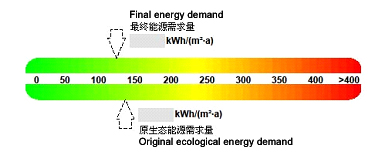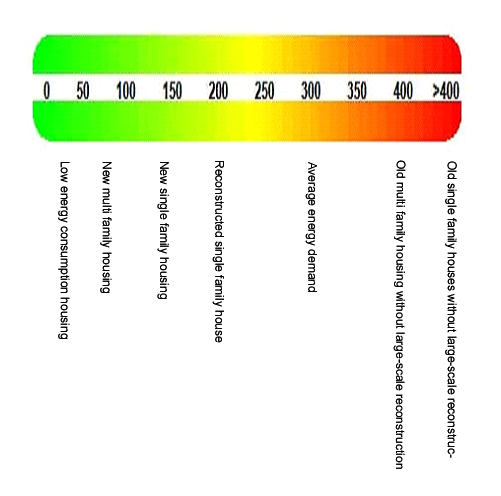
The concept of building energy conservation needs to be deeply rooted in the hearts of the people. It is very important to establish the implementation strategy of building energy conservation, and there must be specific measures and effective methods for the implementation of building energy conservation strategy.
The Building Energy Consumption Certificate
The implementation of building energy consumption certificate is an effective measure for Germany and the European Community to implement building energy conservation strategy. Its meaning is:
▪ Popularize and improve the awareness of building energy consumption and energy conservation to every building, every household and every person.
▪ Investors and builders are encouraged to take energy-saving measures when building and configuring facilities.
▪ Provide building operating cost information for buyers and renters.
▪ Promote and accelerate investment in energy-saving measures for existing buildings.
I Background of implementing the building energy consumption certificate
Germany creatively requires all new buildings to be equipped with building energyconsumption certificates since the first edition of energy conservation norm EnEV 2002. On Dec. 16, 2002, the European Community also issued the regulation "Total Energy Efficiency of Buildings" (2002 / 91 / EG), implemented from Jan. 4, 2003. The regulations stipulate that Member States must determine their own building energy-saving specifications within three years. The regulations require a comprehensive assessment of building energy consumption, including insulation, heating devices, hot water supply, air conditioning system, ventilation, lighting and daylighting. Member States must establish minimum quantitative standards for energy efficiency for new and existing buildings on the basis of a comprehensive assessment of buildings. The building energy consumption performance shall be calculated and the calculation results shall be written into the building energy consumption certificate.This certificate must be presented when approving, building, selling or renting buildings at the latest from Jan. 2006. The implementation of the regulations on building energy consumption certificate has played the role of national mobilization for building energy conservation. The building energy consumption certificate has become the most important measure of buildings in Europe, focusing the attention of all people related to buildings - planners, investors, architects, builders, real estate owners, lessors and users. From the perspective of environmental protection, the energy-saving buildings save energy and reduce pollution; For the designer and builder, it can enable him to obtain more construction projects; Standing in the lessor's position, it is easy for him to rent; For users, it saves money.
The first building energy consumption certificate was hung on the outer wall of the entrance of the city hall in Kassel, Hessen, Germany on July 7, 2004. This is regarded as a model for the implementation of the EC regulation "Total Energy Efficiency of Buildings" and a beacon sign of energy-saving buildings.
II Definition of the building energy consumption certificate
The building energy consumption certificate is defined as a system used to indicate the energy-saving performance and quality of buildings. How to express this system, how to make this system and how to use this system are the implementation deepening and concretization of this conceptual definition.
The function of the building energy consumption certificate is to enable buyers or renters to clearly know the energy-saving performance of buildings, correctly estimate the energy consumption of buildings, and help us quickly accumulate experience and improve sensitivity in judging the energy-saving performance of buildings, and provide important information and basis for the owner to implement appropriate measures to improve and raise the building thermal insulation performance or improve and renovate the building equipment technology. Therefore, the expression of building energy consumption performance in the building energy consumption certificate must not be qualitative, but must be quantitative; The expression should be scientific, objective, realistic and verifiable; The expression should be simple, clear and intuitive, which can be understood by non professionals; The certificate making is inexpensive and easy to popularize; In the process of use, It should play a guiding role in building energy conservation and provides scheme suggestions for improving energy-saving performance.
III Method for evaluating energy consumption performance of the building energy consumption certificate
To implement the quantitative description of the building energy consumption certificate, the first is to create a unified method to evaluate energy consumption performance. In principle, there are two possibilities to determine the energy consumption of buildings:
1. Metering method based on actual energy consumption
Read the energy consumption count of the meter for several years.
The metering work takes a long time, the difference of actual temperature and light every year, the difference of personality requirements for comfort and the difference of consumption level will make the data fluctuate greatly. In addition, these data are not available for new buildings.
The metering method is generally suitable for the statistics of energy consumption of old buildings or for verification.
2. Calculation method based on energy demand
For a long time, the dynamic simulation model has been able to solve the building energy consumption and determine the impact of various actual factors on the building energy consumption. However, there are many information data to be collected and input, the model is complex and inconvenient to use. Germany focuses on using mathematical formulas to accurately calculate the annual energy demand of buildings. However, for old buildings, it may be lack f drawings and other data. The calculation method is generally suitable for counting the energy demand of new buildings or old buildings after reconstruction.
Thanks to today's information sharing technology, database technology and computer technology, computer software is developed to realize and optimize the above two methods to deal with the quantitative description of building energy consumption according to the building energy conservation norm.
The evaluation of building energy consumption is generally aimed at the whole building, typically including independent villas, conjoined villas, multi-storey buildings, high-rise buildings, etc. The geographical environment, construction structure, construction technology, material quality and equipment configuration of the whole building are often consistent and inseparable. When the construction technology and equipment technology of heating and hot water supply are separable and significantly different, the whole building can be divided into independent units for evaluation.
The evaluation of building energy consumption is generally specific to the particular parts of the building, such as suites, glass shed gardens, offices, storage rooms with thermal insulation requirements, etc. There is no need to evaluate the parts without energy consumption, such as cellar, garage, tool room, etc.
IV Expression of the building energy consumption certificate to evaluate energy consumption performance
The calculation method based on energy demand is adopted. On the one hand, according to the specification, the total demand of buildings for final energy materials in spring, summer, autumn and winter should be calculated, which makes it possible to compare the actual energy consumption. On the other hand, it is necessary to calculate the demand of buildings for the main energy, i.e. consumed original ecological energy, which can obtain the loss of energy conversion and evaluate the impact on environmental protection. The calculated data are marked on the second page of the building energy consumption certificate.
The measurement method based on actual energy consumption is adopted. The energy consumption records in the past three years are required to be counted. The processed data is marked on the third page of the building energy consumption certificate.
The data tag value is not intuitive and visual for many end users, which is difficult to understand. Therefore, the scale value is attached to the building energy consumption certificate. It is transformed from the scale method similar to the white energy consumption unit (refrigerator, washing machine, etc.) and marked by the position of the cursor on the color scale. The scale value in the building energy consumption certificate is divided into 10 ( for residential buildings) or 12 ( for non residential buildings) grades that can be adjusted without section. The measuring unit and corresponding energy value are marked on the scale, and the color changes from dark green with low energy consumption to orange mixed with green and red to dark red with high energy consumption from left to right. There can be multiple cursors. The main cursor marks the energy consumption value of the building, and other cursors can mark the energy consumption value required by the corresponding specifications as needed, the energy consumption value that can be achieved after taking measures to improve the energy-saving performance of the building, etc. See figure below.


Scale for Building Energy Consumption
As we read the test sheet in the hospital, we not only care about the test result data, but also want to know how far the test result is from the upper and lower limits of the normal range. A reference scale is also attached to the second and third pages of the energy consumption certificate of residential buildings to clarify the energy-saving performance of buildings through comparison. Please refer to the following figure for the reference scale.

Reference Scale
V Suggestions of the building energy consumption certificate on improving building energy saving performance
The building energy consumption certificate can puts forward one or more schemes and suggestions for improving the energy-saving performance of buildings, such as the reconstruction of roof, exterior wall or windows, the construction of glass shed winter garden or the renewal of heating equipment, etc. Moreover, it makes a quantitative description of the energy-saving benefits that can be achieved by the reconstruction or improvement measures. Thus, the building energy consumption certificate becomes a physical examination certificate plus prescriptions in the sense of building energy conservation. This not only focuses on the proof of the objective status quo, but also actively promotes the next step of building energy conservation.
VI Contents of the building energy consumption certificate and others
At present, there are two kinds of building energy consumption certificates used in Germany: the residential building energy consumption certificate and the non residential building energy consumption certificate. Each certificate is unified into 4 pages. In addition, the special page of suggestions for improving energy-saving performance of buildings can be attached as the fifth page of the certificate. In the certificate to determine objectively and to prepare document the following contents related to quantitative energy consumption evaluation:
Page 1 The building feature description and evaluation method
Page 2 The calculation results based on energy demand
Page 3 The tags based on actual energy consumption
Page 4 The description of pages 2 and 3Page 5 The suggestions on improving energy-saving performance of buildings
The building energy consumption certificate is valid for up to 10 years. The certificate shall be made again after the transform, expansion or reconstruction of the building.
The production cost of the building energy consumption certificate shall be borne by the real estate owner, and shall not be transferred to the buyer or lessee.
Notes: BEE is the abbreviation for Building Energy Efficiency.